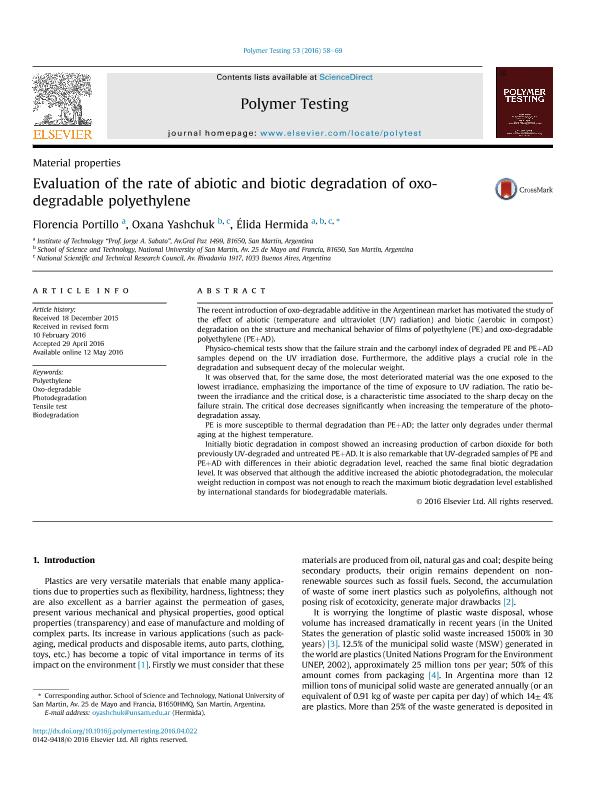Mostrar el registro sencillo del ítem
dc.contributor.author
Portillo, Florencia Soledad

dc.contributor.author
Yashchuk, Oxana

dc.contributor.author
Hermida, Elida Beatriz

dc.date.available
2018-05-03T17:19:33Z
dc.date.issued
2016-08
dc.identifier.citation
Portillo, Florencia Soledad; Yashchuk, Oxana; Hermida, Elida Beatriz; Evaluation of the rate of abiotic and biotic degradation of oxodegradable polyethylene; Elsevier; Polymer Testing; 53; 8-2016; 58-69
dc.identifier.issn
0142-9418
dc.identifier.uri
http://hdl.handle.net/11336/43992
dc.description.abstract
The recent introduction of oxo-degradable additive in the Argentinean market has motivated the study of the effect of abiotic (temperature and ultraviolet (UV) radiation) and biotic (aerobic in compost) degradation on the structure and mechanical behavior of films of polyethylene (PE) and oxo-degradablepolyethylene (PE+AD).Physico-chemical tests show that the failure strain and the carbonyl index of degraded PE and PE+AD samples depend on the UV irradiation dose. Furthermore, the additive plays a crucial role in the degradation and subsequent decay of the molecular weight.It was observed that, for the same dose, the most deteriorated material was the one exposed to the lowest irradiance, emphasizing the importance of the time of exposure to UV radiation. The ratio between the irradiance and the critical dose, is a characteristic time associated to the sharp decay on the failure strain. The critical dose decreases significantly when increasing the temperature of the photodegradation assay.PE is more susceptible to thermal degradation than PE+AD; the latter only degrades under thermal aging at the highest temperature.Initially biotic degradation in compost showed an increasing production of carbon dioxide for both previously UV-degraded and untreated PE+AD. It is also remarkable that UV-degraded samples of PE and PE+AD with differences in their abiotic degradation level, reached the same final biotic degradation level. It was observed that although the additive increased the abiotic photodegradation, the molecular weight reduction in compost was not enough to reach the maximum biotic degradation level established by international standards for biodegradable materials.
dc.format
application/pdf
dc.language.iso
eng
dc.publisher
Elsevier

dc.rights
info:eu-repo/semantics/openAccess
dc.rights.uri
https://creativecommons.org/licenses/by-nc-nd/2.5/ar/
dc.subject
Polyethylene
dc.subject
Oxo-Degradable
dc.subject
Photodegradation
dc.subject
Tensile Test
dc.subject
Biodegradation
dc.subject.classification
Recubrimientos y Películas

dc.subject.classification
Ingeniería de los Materiales

dc.subject.classification
INGENIERÍAS Y TECNOLOGÍAS

dc.title
Evaluation of the rate of abiotic and biotic degradation of oxodegradable polyethylene
dc.type
info:eu-repo/semantics/article
dc.type
info:ar-repo/semantics/artículo
dc.type
info:eu-repo/semantics/publishedVersion
dc.date.updated
2018-05-03T14:01:39Z
dc.journal.volume
53
dc.journal.pagination
58-69
dc.journal.pais
Países Bajos

dc.journal.ciudad
Amsterdam
dc.description.fil
Fil: Portillo, Florencia Soledad. Universidad Nacional de San Martín. Instituto Sabato; Argentina
dc.description.fil
Fil: Yashchuk, Oxana. Consejo Nacional de Investigaciones Científicas y Técnicas; Argentina. Universidad Nacional de San Martín; Argentina
dc.description.fil
Fil: Hermida, Elida Beatriz. Consejo Nacional de Investigaciones Científicas y Técnicas; Argentina. Universidad Nacional de San Martín. Instituto Sabato; Argentina
dc.journal.title
Polymer Testing

dc.relation.alternativeid
info:eu-repo/semantics/altIdentifier/doi/http://dx.doi.org/10.1016/j.polymertesting.2016.04.022
dc.relation.alternativeid
info:eu-repo/semantics/altIdentifier/url/https://www.sciencedirect.com/science/article/pii/S0142941815302956
Archivos asociados
